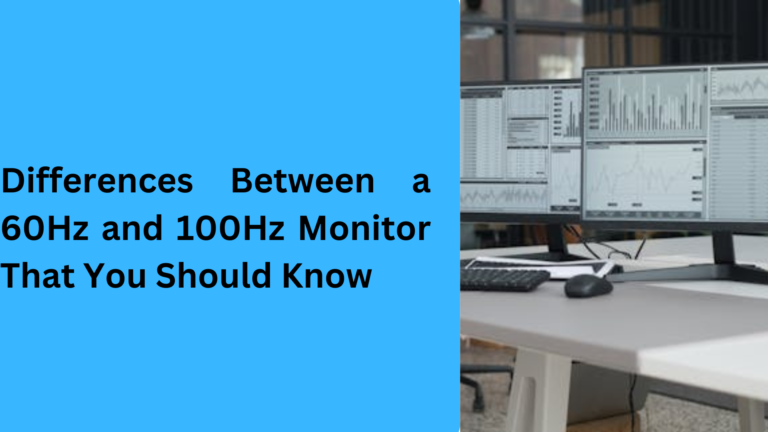10 Key Differences Between Dual Monitors and Ultrawide Monitors You Should Know
In the world of modern computing, dual monitors and ultrawide monitors have become two popular choices for improving productivity, gaming experiences, and even entertainment setups. Understanding the key differences between these two types of displays is crucial for making the right choice for your needs. Whether you’re working from home, gaming, or simply enhancing your computer setup, knowing the benefits of dual monitors versus the advantages of ultrawide monitors can make a big difference. In this guide, we will break down the major differences in easy-to-understand language, using long-tail keywords that help you make an informed decision.
1. Resolution and Screen Size: Dual Monitors vs Ultrawide Monitors for Productivity
One of the most important dual monitors vs ultrawide resolution differences is the amount of screen real estate you get. A dual monitor setup typically consists of two separate monitors, each with its own resolution. For example, if you use two 1080p monitors, you get a combined resolution of 3840×1080 pixels. On the other hand, an ultrawide monitor usually comes with a wider 21:9 aspect ratio that offers resolutions such as 2560×1080 or 3440×1440, depending on the model.
- Dual monitors offer more flexibility in setting up different screen sizes and resolutions.
- Ultrawide monitors provide a continuous panoramic view, eliminating the gap between two screens. This is great for multitasking, video editing, or working with large spreadsheets.
- For multitaskers, ultrawide screens provide more efficient horizontal space.
- If you’re focused on gaming, ultrawide monitors enhance the immersive experience with wider field-of-view support.
2. Set-Up and Configuration: Ease of Setting Up Dual Monitors vs Ultrawide Monitors
Setting up dual monitors and ultrawide monitors may vary in complexity, and it’s important to consider your technical skill level. Dual monitor setups can be as simple as connecting two monitors to a computer using HDMI, DisplayPort, or VGA cables. However, software adjustments are often needed to manage window placement and alignment between the monitors.
- Dual monitors give you the flexibility to arrange them side by side or one above the other, depending on your workspace.
- Ultrawide monitors, in comparison, are generally easier to set up since there’s only one screen to connect. You don’t have to worry about managing multiple displays or adjusting the settings for each monitor.
- For people who prefer a minimalist setup, ultrawide monitors provide a cleaner desk space, with no need for extra cables or monitors.
3. Immersive Experience: Ultrawide Monitors vs Dual Monitors for Gaming and Media
For gamers and movie enthusiasts, the immersive experience is one of the most debated topics between dual monitors and ultrawide monitors. Ultrawide displays are designed for cinematic viewing and immersive gaming, providing a field of view that enhances the overall experience.
- Dual monitors can work well for gaming setups, especially for simultaneous multitasking while gaming, such as having a game on one screen and a walkthrough or streaming service on the other.
- Ultrawide monitors create a more seamless experience with no screen border interruptions. Games, movies, and videos can be viewed in a wider field of view, making it perfect for those who want to be fully immersed in their media.
- The ultrawide gaming experience offers better panoramic gameplay, particularly in racing or open-world games.
4. Multitasking: The Productivity of Dual Monitors vs Ultrawide Monitors
When it comes to multitasking and productivity, both dual monitors and ultrawide monitors offer unique advantages. Dual monitor setups are perfect for those who need to run multiple applications or documents simultaneously.
- With dual monitors, you can easily keep multiple applications open and run them side by side, making tasks like coding, video editing, and financial analysis more efficient.
- Ultrawide monitors, however, eliminate the need for adjusting multiple windows by giving you one continuous workspace. This is ideal for tasks like graphic design, video production, and any work that requires a wide and expansive view.
- If you work in fields such as programming, data analysis, or content creation, the extra screen space of an ultrawide monitor can help you organize your work better.
5. Cost: Dual Monitors vs Ultrawide Monitors – Which Is More Cost-Effective?
The cost of setting up dual monitors versus an ultrawide monitor is a key factor in deciding which setup is better for you. While both options come in a range of price points, there are a few things to consider when it comes to cost-effectiveness.
- A dual monitor setup can be more affordable because you can purchase two separate monitors that are generally lower in price compared to an ultrawide monitor.
- Ultrawide monitors are typically priced higher, but they offer the advantage of eliminating the need for additional hardware like a monitor stand, cables, and extra graphics cards (in some cases).
- Dual monitors may be the better option if you are on a budget and already have an extra screen available.
- If you value streamlined setups and are willing to invest more, ultrawide monitors can be worth the price due to their superior design, enhanced productivity benefits, and gaming experience.
6. Space Efficiency: Dual Monitors vs Ultrawide Monitors for Desk Organization
When it comes to the organization of your desk space, the layout of dual monitors and ultrawide monitors makes a significant difference. Both have their own space requirements, but each option fits differently into a workspace.
- Dual monitors take up more desk space because you need to place two separate screens next to each other. This setup often requires a larger desk and could cause clutter with cables and other equipment.
- Ultrawide monitors, on the other hand, are typically more space-efficient because they combine two screens into one. This means fewer cables and a cleaner workspace, which is perfect for those who want a minimalist or tidy desk setup.
- For users with limited desk space, ultrawide monitors can be a more practical option, giving you the experience of multiple monitors without the physical space demands.
7. Color Accuracy and Viewing Angles: Ultrawide vs Dual Monitors for Professionals
If you’re working in fields like photo editing, graphic design, or video production, color accuracy and viewing angles are important factors to consider when choosing between dual monitors and ultrawide monitors.
- Dual monitors allow you to mix and match monitors with different specifications, so you can choose one with superior color accuracy for professional work. However, the consistency between monitors might not be as reliable.
- Ultrawide monitors, especially those designed for professional use, often provide better color consistency across the entire screen. These monitors are specifically designed for visual tasks and typically offer wider color gamuts, making them ideal for those who need precise colors and sharp images.
- For content creators who rely on color accuracy, an ultrawide monitor with factory calibration could be the better option for consistent and reliable performance across the screen.
8. Energy Consumption: Dual Monitors vs Ultrawide Monitors and Power Usage
Another consideration when deciding between dual monitors and ultrawide monitors is their power consumption. Understanding energy efficiency can help you make a more eco-friendly choice, especially if you are using your monitors for long periods.
- Dual monitor setups require the power consumption of two monitors, meaning they often consume more electricity compared to a single screen. This could impact both your energy bills and the environment.
- Ultrawide monitors, while typically more power-hungry than a single standard monitor, usually consume less power than two monitors combined. With an ultrawide setup, you get a more efficient solution with reduced power consumption compared to the dual-monitor alternative.
9. Portability: Dual Monitors vs Ultrawide Monitors for Flexible Use
When considering portability, it’s important to think about how often you need to move your monitors or set up a mobile workspace.
- Dual monitors are less portable due to the need for two separate screens, stands, and more connections. Setting them up in different locations or traveling with them can be cumbersome.
- Ultrawide monitors, while larger in size, are more portable in comparison because you only need to move one monitor. This makes it easier to transport for people who frequently need to relocate their setup, such as freelancers or people who work from multiple locations.
10. Customizability and Flexibility: Dual Monitors vs Ultrawide Monitors for Different Workflows
The flexibility in setting up and customizing your workspace is another factor that sets dual monitors apart from ultrawide monitors.
- Dual monitors allow for a high degree of customization in terms of positioning, including the option to rotate one monitor into portrait mode or adjust the monitors at different angles to suit your needs. This can be especially useful for specific tasks, like coding or document editing.
- Ultrawide monitors generally offer less flexibility in positioning since it is a single screen. However, many modern ultrawide monitors come with features like split-screen options that mimic the functionality of two monitors, offering some level of customization for multitasking.
Ultimately, dual monitors provide more adaptability for a variety of workflows, while ultrawide monitors offer a more streamlined, all-in-one solution for those who need wide views but don’t require adjustable screen setups.
1. What is the difference between a dual monitor setup and an ultrawide monitor for productivity?
A dual monitor setup offers flexibility by allowing you to arrange two separate screens side by side, which can be beneficial for tasks like multitasking, coding, or data analysis. However, it requires managing multiple displays and their settings. In contrast, an ultrawide monitor offers a continuous panoramic screen, ideal for seamless multitasking, graphic design, and video editing, as you don’t have to deal with the gap between monitors. The choice depends on whether you prefer more screen space (ultrawide) or flexibility in positioning (dual monitors).
2. Are dual monitors better than ultrawide monitors for gaming and entertainment?
For gaming and entertainment, ultrawide monitors tend to provide a more immersive experience, especially in open-world games or those that support ultrawide resolutions. They deliver a wider field of view without the distraction of bezels between screens, enhancing the visual experience. On the other hand, dual monitor setups allow you to multi-task while gaming, such as running a game on one screen and watching a video or browsing the web on another, offering versatility but not the same level of immersion as an ultrawide screen.
3. What is the best setup for multitasking: dual monitors or ultrawide monitors?
If your primary goal is multitasking—such as managing multiple windows, apps, or documents—both setups offer benefits. Dual monitors provide the advantage of using two independent screens, which can be placed at different angles or even in a portrait orientation. This gives you ultimate control over the layout. However, an ultrawide monitor is often a better solution for those who prefer a continuous workspace, eliminating the need to adjust windows between two screens. For professionals in fields like content creation or programming, ultrawide monitors offer a more expansive view.
4. Are dual monitors cheaper than ultrawide monitors?
In general, dual monitors tend to be a more affordable option than an ultrawide monitor because you’re purchasing two separate screens. With a dual monitor setup, you can choose monitors that fit your budget and combine them for an effective workspace. Ultrawide monitors, especially high-quality ones with 4K resolution or high refresh rates, are typically more expensive but offer a single, seamless display. If you’re on a budget but need more screen space, dual monitors may be a cost-effective solution.
5. How do I choose between dual monitors and an ultrawide monitor for my desk space?
When deciding between dual monitors and an ultrawide monitor for desk space, consider the layout and amount of space you have available. Dual monitors require a larger desk area for both screens and their stands, which can lead to a more cluttered desk. However, if you enjoy the flexibility of separate screens and a customized setup, this might be a good fit. On the other hand, an ultrawide monitor offers a more compact solution, as it combines the benefits of two monitors into one, reducing the overall desk footprint. If space-saving is a priority, an ultrawide monitor is likely the better option.



